| View previous topic :: View next topic |
| Author |
Message |
vrig
Joined: 01 Jul 2020
Posts: 6
Location: colorado


|
 Posted: Jul 01, 2020 18:05 Post subject: Colorado Stone Posted: Jul 01, 2020 18:05 Post subject: Colorado Stone |
|
|
I live SW of Denver in the foothills at 8500 ft. We have 5 acres of land with a lot of typical outcropping pink granite, cut by quartz veins. Recently I found these strange green colored round boulders outcropping near the crest of a small hill. They are very different from the surrounding granite, and extremely heavy and dense. They remind me of geodes but I don't think that's consistent with the surrounding rock. They are a variety of sizes from 8 inches across to a couple feet. I believe the white color is quartz or calcite fracture filling. Any ideas on the green rock? Is it possibly basalt? I have not seen any similar material anywhere in the area. But I really like the form and appearance and have been using for landscape material.
Thanks
| Dimensions: | 24 x 24 inches |
| Description: |
|
| Viewed: |
10123 Time(s) |
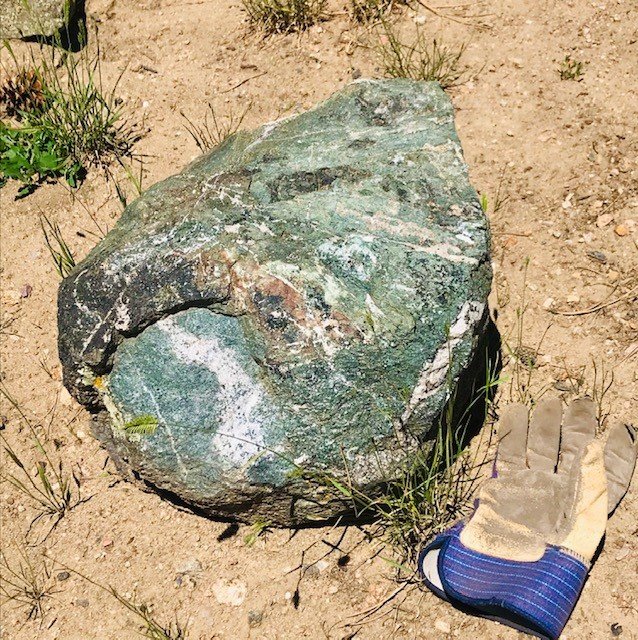
|
|
|
| Back to top |
|
 |
Pete Richards
Site Admin
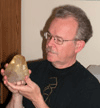
Joined: 29 Dec 2008
Posts: 842
Location: Northeast Ohio



|
 Posted: Jul 01, 2020 18:32 Post subject: Re: Colorado Stone Posted: Jul 01, 2020 18:32 Post subject: Re: Colorado Stone |
|
|
Some pictures showing details of the green areas and their texture would help.
The round shape suggests geodes, as you say, but the heaviness does not. Since geodes (at least the ones rock collectors want) are hollow, they tend to be more on the light side. The green color and general appearance also do not suggest geodes.
Are there a lot of these green boulders? Are they all in one area, or are they spread around? Is there higher terrain where you found these, where the source might be?
What is the general lay of your land? Are you at the top of a hill? In a valley? In or near a river or stream floodplain? Were there formerly glaciers in your area?
All of this might help to make better guesses about those green boulders.
_________________
Collecting and studying crystals with interesting habits, twinning, and epitaxy |
|
| Back to top |
|
 |
vrig
Joined: 01 Jul 2020
Posts: 6
Location: colorado


|
 Posted: Jul 01, 2020 19:02 Post subject: Re: Colorado Stone Posted: Jul 01, 2020 19:02 Post subject: Re: Colorado Stone |
|
|
Good questions:
There are maybe 40-50 boulders in a very small area, and a lot were buried all near the crest of a ridge but high above the valley floor below us (see picture). I believe they are all in-situ and were not depositional. I have not seen anything like these anywhere in the area, but they only cover an area about 50x50 ft. I don't believe they are glacial deposits either.
| Description: |
|
| Viewed: |
10087 Time(s) |
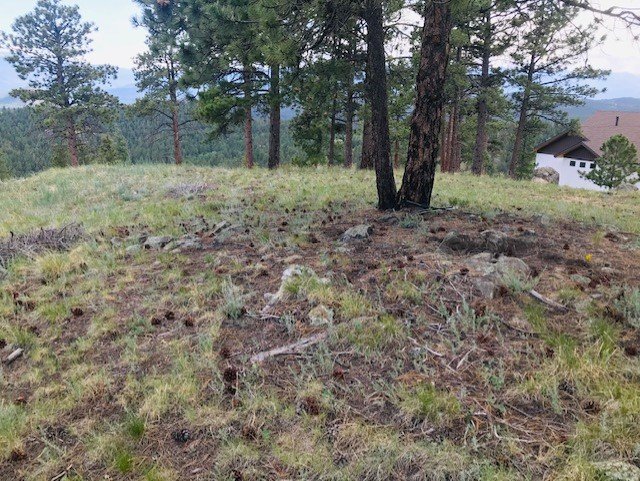
|
|
|
| Back to top |
|
 |
vrig
Joined: 01 Jul 2020
Posts: 6
Location: colorado


|
 Posted: Jul 01, 2020 19:02 Post subject: Re: Colorado Stone Posted: Jul 01, 2020 19:02 Post subject: Re: Colorado Stone |
|
|
Here is a close up
| Description: |
|
| Viewed: |
10085 Time(s) |
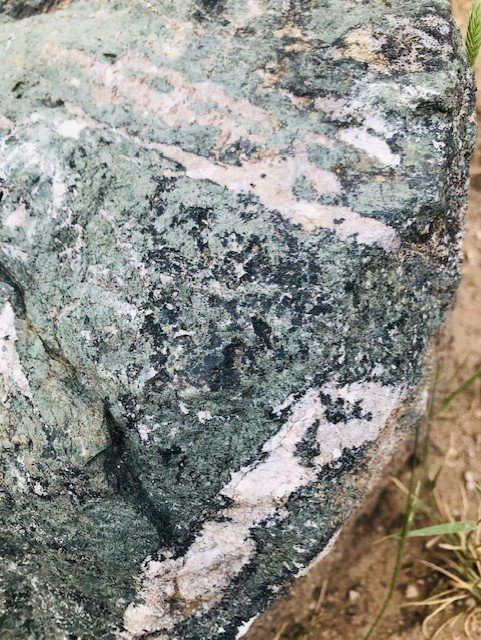
|
|
|
| Back to top |
|
 |
Bob Carnein
Joined: 22 Aug 2013
Posts: 352
Location: Florissant, CO



|
 Posted: Jul 01, 2020 19:11 Post subject: Re: Colorado Stone Posted: Jul 01, 2020 19:11 Post subject: Re: Colorado Stone |
|
|
| I'd guess (and it's really just that, without actually seeing the rocks) that they are pieces of lime-silicate rock from the 1.75-Ga Idaho Springs Fm. (actually a group of formations) that represent metasediments and metavolcanics deposited some 2Ga and then metamorphosed in the earliest orogeny for which there is evidence in central Colorado. They definitely are not geodes. Lime silicate rocks mostly come from metamorphism of impure (clayey or sandy) limestone or calcareous shales, siltstones, and sandstones. They typically have a gneissic structure (irregular bands of different minerals, giving the rock a "striped" appearance). The Idaho Springs often occurs as large xenoliths or roof pendants in the granite (in this case, probably Pikes Peak Granite, which is 1.04Ga).
|
|
| Back to top |
|
 |
vrig
Joined: 01 Jul 2020
Posts: 6
Location: colorado


|
 Posted: Jul 01, 2020 20:59 Post subject: Re: Colorado Stone Posted: Jul 01, 2020 20:59 Post subject: Re: Colorado Stone |
|
|
| Interesting comments Bob, thank you. Some of these have pronounced banding, I will take a couple more pics in the morning and post them. Would it be normal for those to be such a small localized deposit?
|
|
| Back to top |
|
 |
SteveB
Joined: 12 Oct 2015
Posts: 238
Location: Canberra


|
 Posted: Jul 02, 2020 03:17 Post subject: Re: Colorado Stone Posted: Jul 02, 2020 03:17 Post subject: Re: Colorado Stone |
|
|
I’m thinking along the lines of a kimberlite and possibly a gypsum for the white. You could try testing with Hydrochloric acid for reactions to help identify the minerals of the rocks.
Another thought is the placement could be of indigenous peoples significance and I would not recommend disturbing the spot by digging or removing rocks. It may be anatural formation too its hard to tell, either way i think you should contact a university professor of archeology regarding a good way to map the site in order that determine more about its possible origins. Mapping or photographing from above can be of help here, got a friend with a drone? If it was me I would use photogrammetry to produce a 3d model so i could view from any position and produce a map of object positions.
Secondly are the rocks all of similar size and shape? Are they maybe water worn or sharply fragmented or are there distinct cleavage planes. Logically if they weren't formed there then they should be from nearby locality. You can check around local waterways, maybe a previous landowner just found a heap of interesting green rocks and wanted to make a rock garden or a nice spot to sit in the evening. Something that is common to new communities or towns is they made use of local materials to build and decorate civic buildings. So i would check your town centers more historic buildings And see if they used similar green rocks in the architecture like window sills or stairs. Historic buildings are often well documented with information of building materials used and where they came from.small quarries are common everywhere that fed growing settlements and are now overgrown public lands.
So plenty to research without disturbing the site just yet and tests to do, i wouldnt discount glacial deposition just yet either. Gather more data first as visual identification is very difficult for most rocks in existence if not, impossible. Consult a local university archeology and geology staff first for further advice, dont take a rock in to them as the source situ is often vital to any identification and the moment you move a rock that information is lost for it forever even if you write it down as surround soil sampling is common for rock and mineral identification as well as archeological dating. I think its an exciting investigation opportunity you have there. They are not giant nuggets of gold someone is going to steal nor are they going to run away on there own so care and patience will serve youbwell in they long run..
Steve
|
|
| Back to top |
|
 |
vrig
Joined: 01 Jul 2020
Posts: 6
Location: colorado


|
 Posted: Jul 02, 2020 10:15 Post subject: Re: Colorado Stone Posted: Jul 02, 2020 10:15 Post subject: Re: Colorado Stone |
|
|
Here are a couple more pictures, the smaller rock is 8 inches around and weighs 24 pounds. The bigger rock has more pronounced banding while the rounder ones don't. However even the round ones are very rough and coarse on the outside, they don't appear to have been transported or weathered at all. I cant really find a contact on the ground between this green rock and the surrounding granite, it is a roughly circular outcropping almost like an "upwelling".
| Description: |
|
| Viewed: |
9939 Time(s) |
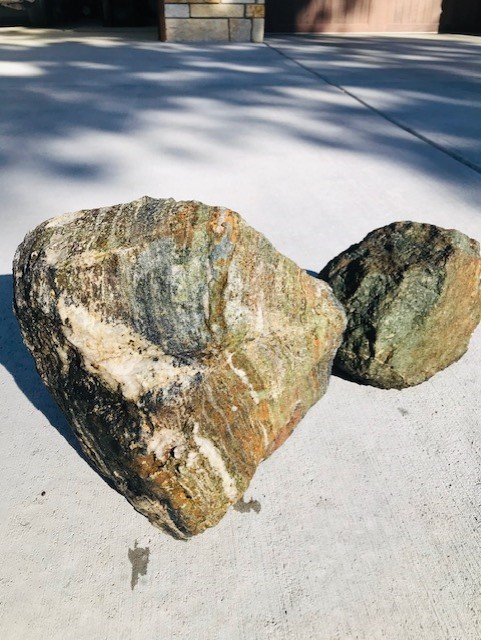
|
|
|
| Back to top |
|
 |
vrig
Joined: 01 Jul 2020
Posts: 6
Location: colorado


|
 Posted: Jul 02, 2020 10:17 Post subject: Re: Colorado Stone Posted: Jul 02, 2020 10:17 Post subject: Re: Colorado Stone |
|
|
Close up of the smaller rock
| Description: |
|
| Viewed: |
9958 Time(s) |
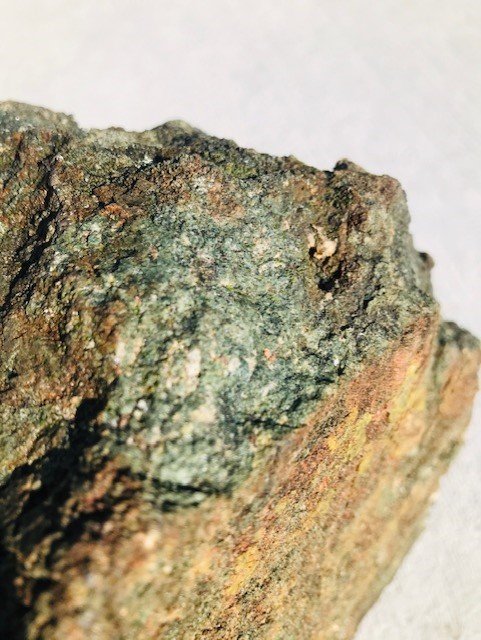
|
|
|
| Back to top |
|
 |
Kevin Schofield

Joined: 05 Jan 2018
Posts: 169
Location: Beacon NY



|
 Posted: Jul 02, 2020 12:47 Post subject: Re: Colorado Stone Posted: Jul 02, 2020 12:47 Post subject: Re: Colorado Stone |
|
|
| vrig wrote: | | Close up of the smaller rock |
I agree with Bob C. These look very much from their macro-textures to be pieces of metamorphic rock. That being the case, although I don't know enough of the geology of the area to say yea or nay on the specifics of the ages, the idea that this very localized occurrence is made up of fragments of a roof pendant or xenoliths "stoped" into the granite as it was emplaced.
_________________
Veni, Vidi, Emi |
|
| Back to top |
|
 |
|




